#Optical technology
Explore tagged Tumblr posts
Text
Clarity Unveiled: Exploring Trends and Innovations in the Anti-Reflective Coatings Market
According to a statement by P&S Intelligence, the anti-reflective coatings market will generate USD 8,577.3 million, growing at a rate of 7.3%, by 2030.
The main factors boosting the growth of the industry include the increasing requirement for anti-reflection coats in the photovoltaic and eyewear industries, along with the rising implementation of anti-reflective eyeglasses in the construction sector.

Based on application, solar panels will witness the highest growth rate, of approximately 8%, in the years to come. This is credited to the growing requirement for low-cost solar cells with enhanced reliability and robustness, extensive adoption of these coatings in solar panels to rise their overall effectiveness, and the growing need to lessen photovoltaic surface reflection.
Furthermore, the electronics industry is the most-important end user in the industry because of the growing flat-panel displays popularity and increasing smartphone industry.
The growth of the anti-reflective coatings market is also driven by the increasing usage of these coatings in the eyewear industry, as the industry adopted such materials in high-light-transmitting products, for instance, eyeglasses and lenses.
Additionally, the advancement of technology in eyewear and the expansion of this industry because of the increasing prevalence of vision impairment, as well as the rising elderly populace, will further boost the growth of the industry.
In the past few years, vacuum deposition held the largest revenue share, of more than 35%, and it will propel with a significant growth rate throughout this decade. This is because of the extensive adoption of the deposition method in the application of antireflective coatings, because of its maximum adaptability, fast setting, affordability, and lesser environmental impact. The APAC industry held the largest revenue share, of more than 35%, and it will propel at a significant rate because of the increasing requirement for logistics packaging and aerospace sector expansion.
Moreover, North America accounted for a significant share of the anti-reflective coatings industry. This is credited to the existence of a large number of reputable companies, rising discretionary expenditure by consumers, growing consciousness about the benefits of coated eyeglasses, booming automotive sector, and increasing construction industry.
#Anti-reflective coatings market#Trends#Innovations#Optical technology#Eyewear#Camera lenses#Solar panels#Displays#Market dynamics#Technological advancements#Investment prospects
0 notes
Text
All-Star Moments in Space Communications and Navigation
How do we get information from missions exploring the cosmos back to humans on Earth? Our space communications and navigation networks – the Near Space Network and the Deep Space Network – bring back science and exploration data daily.
Here are a few of our favorite moments from 2024.
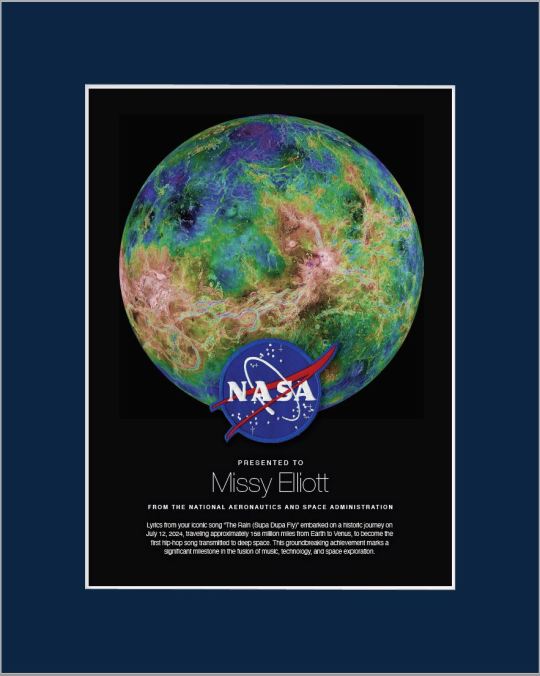
1. Hip-Hop to Deep Space
The stars above and on Earth aligned as lyrics from the song “The Rain (Supa Dupa Fly)” by hip-hop artist Missy Elliott were beamed to Venus via NASA’s Deep Space Network. Using a 34-meter (112-foot) wide Deep Space Station 13 (DSS-13) radio dish antenna, located at the network’s Goldstone Deep Space Communications Complex in California, the song was sent at 10:05 a.m. PDT on Friday, July 12 and traveled about 158 million miles from Earth to Venus — the artist’s favorite planet. Coincidentally, the DSS-13 that sent the transmission is also nicknamed Venus!

NASA's PACE mission transmitting data to Earth through NASA's Near Space Network.
2. Lemme Upgrade You
Our Near Space Network, which supports communications for space-based missions within 1.2 million miles of Earth, is constantly enhancing its capabilities to support science and exploration missions. Last year, the network implemented DTN (Delay/Disruption Tolerant Networking), which provides robust protection of data traveling from extreme distances. NASA’s PACE (Plankton, Aerosol, Cloud, ocean Ecosystem) mission is the first operational science mission to leverage the network’s DTN capabilities. Since PACE’s launch, over 17 million bundles of data have been transmitted by the satellite and received by the network’s ground station.
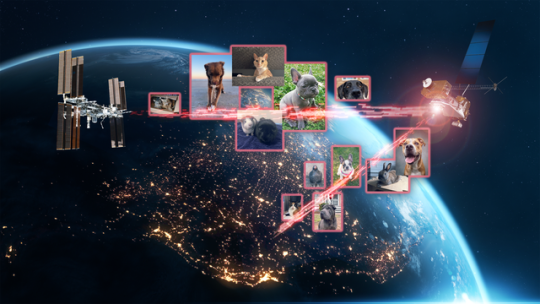
A collage of the pet photos sent over laser links from Earth to LCRD and finally to ILLUMA-T (Integrated LCRD Low Earth Orbit User Modem and Amplifier Terminal) on the International Space Station. Animals submitted include cats, dogs, birds, chickens, cows, snakes, and pigs.
3. Who Doesn’t Love Pets?
Last year, we transmitted hundreds of pet photos and videos to the International Space Station, showcasing how laser communications can send more data at once than traditional methods. Imagery of cherished pets gathered from NASA astronauts and agency employees flowed from the mission ops center to the optical ground stations and then to the in-space Laser Communications Relay Demonstration (LCRD), which relayed the signal to a payload on the space station. This activity demonstrated how laser communications and high-rate DTN can benefit human spaceflight missions.

4K video footage was routed from the PC-12 aircraft to an optical ground station in Cleveland. From there, it was sent over an Earth-based network to NASA’s White Sands Test Facility in Las Cruces, New Mexico. The signals were then sent to NASA’s Laser Communications Relay Demonstration spacecraft and relayed to the ILLUMA-T payload on the International Space Station.
4. Now Streaming
A team of engineers transmitted 4K video footage from an aircraft to the International Space Station and back using laser communication signals. Historically, we have relied on radio waves to send information to and from space. Laser communications use infrared light to transmit 10 to 100 times more data than radio frequency systems. The flight tests were part of an agency initiative to stream high-bandwidth video and other data from deep space, enabling future human missions beyond low-Earth orbit.

The Near Space Network provides missions within 1.2 million miles of Earth with communications and navigation services.
5. New Year, New Relationships
At the very end of 2024, the Near Space Network announced multiple contract awards to enhance the network’s services portfolio. The network, which uses a blend of government and commercial assets to get data to and from spacecraft, will be able to support more missions observing our Earth and exploring the cosmos. These commercial assets, alongside the existing network, will also play a critical role in our Artemis campaign, which calls for long-term exploration of the Moon.

On Monday, Oct. 14, 2024, at 12:06 p.m. EDT, a SpaceX Falcon Heavy rocket carrying NASA’s Europa Clipper spacecraft lifts off from Launch Complex 39A at NASA’s Kennedy Space Center in Florida.
6. 3, 2, 1, Blast Off!
Together, the Near Space Network and the Deep Space Network supported the launch of Europa Clipper. The Near Space Network provided communications and navigation services to SpaceX’s Falcon Heavy rocket, which launched this Jupiter-bound mission into space! After vehicle separation, the Deep Space Network acquired Europa Clipper’s signal and began full mission support. This is another example of how these networks work together seamlessly to ensure critical mission success.

Engineer Adam Gannon works on the development of Cognitive Engine-1 in the Cognitive Communications Lab at NASA’s Glenn Research Center.
7. Make Way for Next-Gen Tech
Our Technology Education Satellite program organizes collaborative missions that pair university students with researchers to evaluate how new technologies work on small satellites, also known as CubeSats. In 2024, cognitive communications technology, designed to enable autonomous space communications systems, was successfully tested in space on the Technology Educational Satellite 11 mission. Autonomous systems use technology reactive to their environment to implement updates during a spaceflight mission without needing human interaction post-launch.
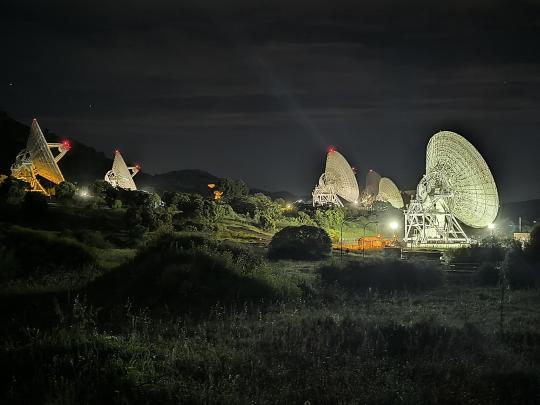
A first: All six radio frequency antennas at the Madrid Deep Space Communication Complex, part of NASA’s Deep Space Network (DSN), carried out a test to receive data from the agency’s Voyager 1 spacecraft at the same time.
8. Six Are Better Than One
On April 20, 2024, all six radio frequency antennas at the Madrid Deep Space Communication Complex, part of our Deep Space Network, carried out a test to receive data from the agency’s Voyager 1 spacecraft at the same time. Combining the antennas’ receiving power, or arraying, lets the network collect the very faint signals from faraway spacecraft.
Here’s to another year connecting Earth and space.
Make sure to follow us on Tumblr for your regular dose of space!
1K notes
·
View notes
Text

In 2024, Japan set a new internet speed world record, achieving 402 terabits per second using standard commercial optical fiber. This speed is sufficient to download 50,000 full HD movies in one second.
303 notes
·
View notes
Text

#military#aesthetic#optic#opticblanc#photography#aesthetics#grungy aesthetic#plane#technology#airplane#airforce
49 notes
·
View notes
Text
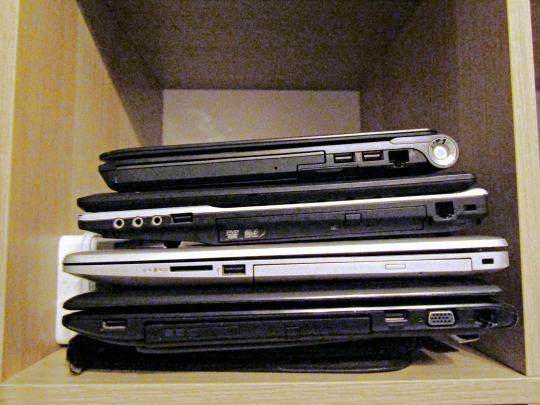
this might be too kinky for tumblr but here are our 4 laptops on their optic drives side 💿🫣
24 notes
·
View notes
Text

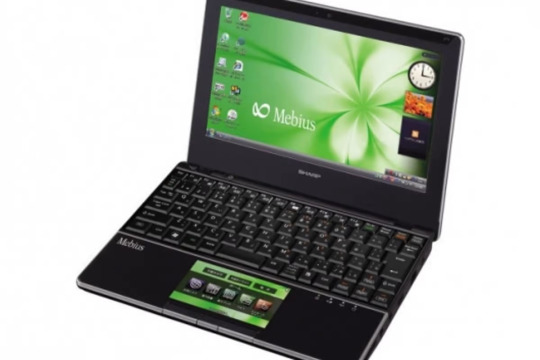

Sharp Releases Notebook PC with Optical Sensor LCD Pad (2009)
#2009#2000s#09#00s#art#black#computer#design#frutiger aero#graphic design#graphics#laptop#pc#photos#sharp optical sensor laptop#sharp#techcore#technology#white
141 notes
·
View notes
Text
This is called a Ponzo illusion.
#science#technology#interesting#random interesting#magic#art#art work#funny#optical illusion#illusion
6 notes
·
View notes
Text
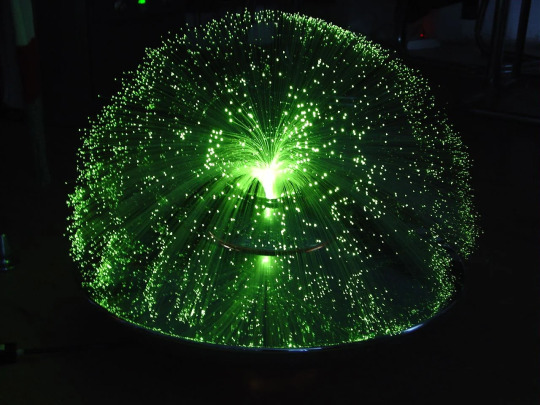
Fiber optic lamp, Carrara, Italy, 1970.
124 notes
·
View notes
Text

Tapered polymer fibers enhance light delivery for neuroscience research
Researchers have developed a reliable and reproducible way to fabricate tapered polymer optical fibers that can be used to deliver light to the brain. These fibers could be used in animal studies to help scientists better understand treatments and interventions for various neurological conditions. The tapered fibers are optimized for neuroscience research techniques, such as optogenetic experiments and fiber photometry, which rely on the interaction between genetically modified neurons and visible light delivered to and/or collected from the brain. "Unlike standard optical fibers, which are cylindrical, the tapered fibers we developed have a conical shape, which allows them to penetrate the tissue with more ease and to deliver light to larger volumes of the brain," said research team member Marcello Meneghetti from the Neural Devices and Gas Photonics group at the Technical University of Denmark.
Read more.
11 notes
·
View notes
Text
AI Tool Reproduces Ancient Cuneiform Characters with High Accuracy

ProtoSnap, developed by Cornell and Tel Aviv universities, aligns prototype signs to photographed clay tablets to decode thousands of years of Mesopotamian writing.
Cornell University researchers report that scholars can now use artificial intelligence to “identify and copy over cuneiform characters from photos of tablets,” greatly easing the reading of these intricate scripts.
The new method, called ProtoSnap, effectively “snaps” a skeletal template of a cuneiform sign onto the image of a tablet, aligning the prototype to the strokes actually impressed in the clay.
By fitting each character’s prototype to its real-world variation, the system can produce an accurate copy of any sign and even reproduce entire tablets.
"Cuneiform, like Egyptian hieroglyphs, is one of the oldest known writing systems and contains over 1,000 unique symbols.
Its characters change shape dramatically across different eras, cultures and even individual scribes so that even the same character… looks different across time,” Cornell computer scientist Hadar Averbuch-Elor explains.
This extreme variability has long made automated reading of cuneiform a very challenging problem.
The ProtoSnap technique addresses this by using a generative AI model known as a diffusion model.
It compares each pixel of a photographed tablet character to a reference prototype sign, calculating deep-feature similarities.
Once the correspondences are found, the AI aligns the prototype skeleton to the tablet’s marking and “snaps” it into place so that the template matches the actual strokes.
In effect, the system corrects for differences in writing style or tablet wear by deforming the ideal prototype to fit the real inscription.
Crucially, the corrected (or “snapped”) character images can then train other AI tools.
The researchers used these aligned signs to train optical-character-recognition models that turn tablet photos into machine-readable text.
They found the models trained on ProtoSnap data performed much better than previous approaches at recognizing cuneiform signs, especially the rare ones or those with highly varied forms.
In practical terms, this means the AI can read and copy symbols that earlier methods often missed.
This advance could save scholars enormous amounts of time.
Traditionally, experts painstakingly hand-copy each cuneiform sign on a tablet.
The AI method can automate that process, freeing specialists to focus on interpretation.
It also enables large-scale comparisons of handwriting across time and place, something too laborious to do by hand.
As Tel Aviv University archaeologist Yoram Cohen says, the goal is to “increase the ancient sources available to us by tenfold,” allowing big-data analysis of how ancient societies lived – from their religion and economy to their laws and social life.
The research was led by Hadar Averbuch-Elor of Cornell Tech and carried out jointly with colleagues at Tel Aviv University.
Graduate student Rachel Mikulinsky, a co-first author, will present the work – titled “ProtoSnap: Prototype Alignment for Cuneiform Signs” – at the International Conference on Learning Representations (ICLR) in April.
In all, roughly 500,000 cuneiform tablets are stored in museums worldwide, but only a small fraction have ever been translated and published.
By giving AI a way to automatically interpret the vast trove of tablet images, the ProtoSnap method could unlock centuries of untapped knowledge about the ancient world.
#protosnap#artificial intelligence#a.i#cuneiform#Egyptian hieroglyphs#prototype#symbols#writing systems#diffusion model#optical-character-recognition#machine-readable text#Cornell Tech#Tel Aviv University#International Conference on Learning Representations (ICLR)#cuneiform tablets#ancient world#ancient civilizations#technology#science#clay tablet#Mesopotamian writing
8 notes
·
View notes
Text
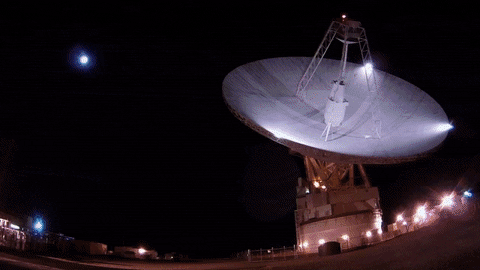
9 Out-of-This-World Moments for Space Communications & Navigation in 2023
How do astronauts and spacecraft communicate with Earth?
By using relay satellites and giant antennas around the globe! These tools are crucial to NASA’s space communications networks: the Near Space Network and the Deep Space Network, which bring back science and exploration data every day.
It’s been a great year for our space communications and navigation community, who work to maintain the networks and enhance NASA’s capabilities. Keep scrolling to learn more about our top nine moments.

The SpaceX Falcon 9 rocket carrying the Dragon spacecraft lifts off from Launch Complex 39A at NASA's Kennedy Space Center in Florida on Thursday, Nov. 9, 2023, on the company's 29th commercial resupply services mission for the agency to the International Space Station. Liftoff was at 8:28 p.m. EST.
1. In November, we launched a laser communications payload, known as ILLUMA-T, to the International Space Station. Now, ILLUMA-T and the Laser Communications Relay Demonstration (LCRD) are exchanging data and officially complete NASA’s first two-way, end-to-end laser relay system. Laser communications can send more data at once than traditional radio wave systems – think upgrading from dial-up to fiber optic internet. ILLUMA-T and LCRD are chatting at 1.2 gigabits per second (Gbps). At that rate, you could download an average movie in under a minute.
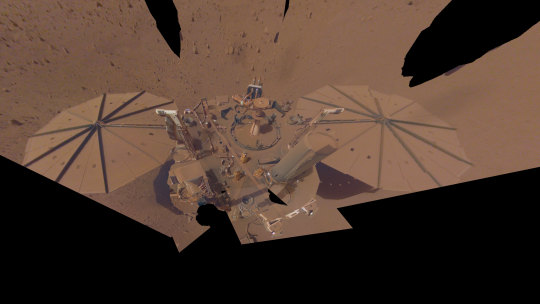
NASA’s InSight lander captured this selfie on Mars on April 24, 2022, the 1,211th Martian day, or sol, of the mission.
2. Data analyzed in 2023 from NASA’s retired InSight Mars lander provided new details about how fast the Red Planet rotates and how much it wobbles. Scientists leveraged InSight’s advanced radio technology, upgrades to the Deep Space Network, and radio signals to determine that Mars’ spin rate is increasing, while making the most precise measurements ever of Mars’ rotation.
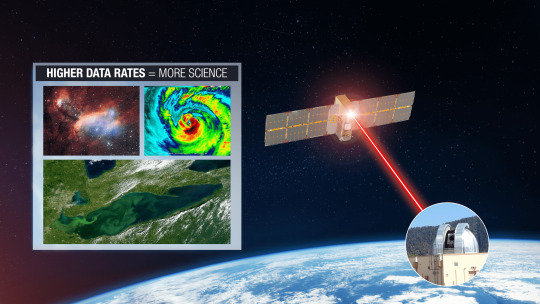
TBIRD is demonstrating a direct-to-Earth laser communications link from low Earth orbit to a ground station on Earth.
3. We set a new high record! The TeraByte InfraRed Delivery (TBIRD) payload – also demonstrating laser communications like ILLUMA-T and LCRD – downlinked 4.8 terabytes of data at 200 Gbps in a single 5-minute pass. This is the highest data rate ever achieved by laser communications technology. To put it in perspective a single terabyte is the equivalent of about 500 hours of high-definition video.
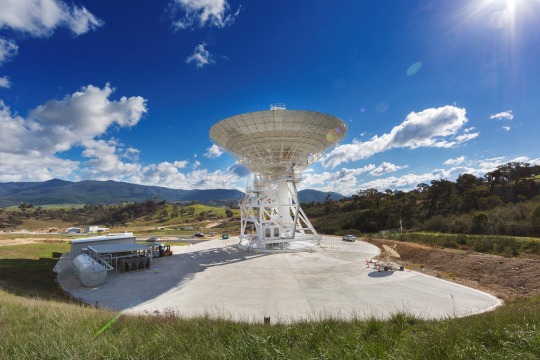
A 34-meter (112-foot) wide antenna at Canberra Deep Space Communications Complex near Canberra, Australia.
4. This year we celebrated the Deep Space Network’s 60th anniversary. This international array of antennas located at three complexes in California, Spain, and Australia allow us to communicate with spacecraft at the Moon and beyond. Learn more about the Deep Space Network’s legacy and future advancements.

An illustration of the LunaNet architecture. LunaNet will bring internet-like services to the Moon.
5. We are bringing humans to the Moon with Artemis missions. During expeditions, astronauts exploring the surface are going to need internet-like capabilities to talk to mission control, understand their routes, and ensure overall safety. The space comm and nav group is working with international partners and commercial companies to develop LunaNet, and in 2023, the team released Draft LunaNet Specification Version 5, furthering development.
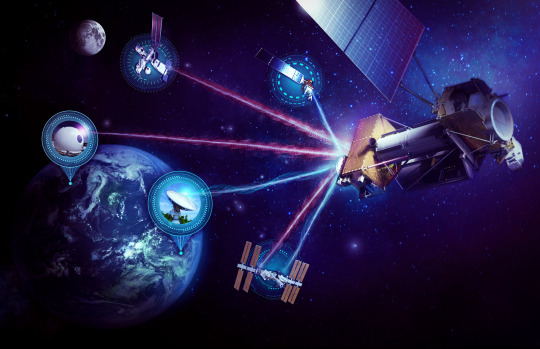
The High-Rate Delay Tolerant Networking node launched to the International Space Station in November and will act as a high-speed path for data.
6. In addition to laser communications, ILLUMA-T on the International Space Station is also demonstrating high-rate delay/disruption tolerant networking (HDTN). The networking node is showcasing a high-speed data path and a store-and-forward technique. HDTN ensures data reaches its final destination and isn’t lost on its path due to a disruption or delay, which are frequent in the space environment.
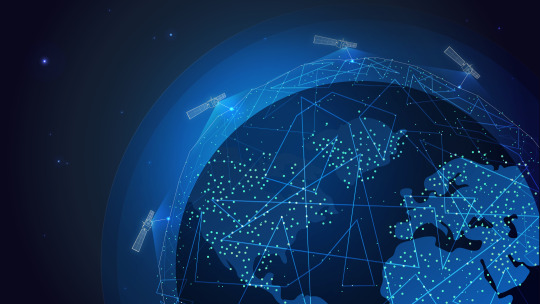
The Communications Services Project (CSP) partners with commercial industry to provide networking options for future spaceflight missions.
7. The space comm and nav team is embracing the growing aerospace industry by partnering with commercial companies to provide multiple networking options for science and exploration missions. Throughout 2023, our commercialization groups engaged with over 110 companies through events, one-on-one meetings, forums, conferences, and more. Over the next decade, NASA plans to transition near-Earth services from government assets to commercial infrastructure.

Middle and high school students solve a coding experiment during NASA's Office of STEM Engagement App Development Challenge.
8. Every year, NASA’s Office of STEM Engagement sponsors the App Development Challenge, wherein middle and high school students must solve a coding challenge. This year, student groups coded an application to visualize the Moon’s South Pole region and display information for navigating the Moon’s surface. Our space communications and navigation experts judged and interviewed students about their projects and the top teams visited NASA’s Johnson Space Center in Houston!

A SpaceX Falcon 9 rocket soars upward after liftoff at the pad at 3:27 a.m. EDT on Saturday, Aug. 26, from Kennedy Space Center’s Launch Complex 39A in Florida carrying NASA’s SpaceX Crew-7 crew members to the International Space Station. Aboard SpaceX’s Dragon spacecraft are NASA astronaut Jasmin Moghbeli, ESA (European Space Agency) astronaut Andreas Mogensen, JAXA (Japan Aerospace Exploration Agency) astronaut Satoshi Furukawa, and Roscosmos cosmonaut Konstantin Borisov.
9. The Near Space Network supported 19 launches in 2023! Launches included Commercial Crew flights to the International Space Station, science mission launches like XRISM and the SuperBIT balloon, and many more. Once in orbit, these satellites use Near Space Network antennas and relays to send their critical data to Earth. In 2023, the Near Space Network provided over 10 million minutes of communications support to missions in space.
Here’s to another year connecting Earth and space.
Make sure to follow us on Tumblr for your regular dose of space!
1K notes
·
View notes
Text
"European researchers are developing quantum computers using light and glass, in a collaboration that promises breakthroughs in computing power, battery technology and scientific discovery."
"Unlike the computers and smartphones we use every day that rely on silicon chips and moving electrons, photonic quantum computers harness the power of light particles, or photons, to process information at astonishing speeds."
"The chips manufactured by Ephos use light, rather than electricity, to process information. They feature up to 200 reconfigurable optical modes, allowing them to dynamically adjust how light spreads across the chip.
But working with light at such a tiny scale is not easy.
"You have to use materials that can transmit light. This is challenging because you have to confine light, but avoid absorption," said Acconcia. "If it is absorbed, it won't travel.""
"One of their most promising innovations is laser writing in glass, a cutting-edge technique developed by Ephos that could help quantum technology reach new heights.
Ephos is unique in making quantum photonic chips out of glass.
In their process, light particles are generated and travel along an optical fiber and into this chip. Everything is made from glass, so there is less risk of photons straying along the way."
continue reading article
#light#glass#quantum physics#quantum computing#technology#innovation#science#optics#photonics#quantum technology#physics#power#energy#light particles#photons#information#lasers#speed#collaboration
4 notes
·
View notes
Text
Physicists in the Harvard John A. Paulson School of Engineering and Applied Sciences (SEAS) have created a compact laser that emits extremely bright, short pulses of light in a useful but difficult-to-achieve wavelength range, packing the performance of larger photonic devices onto a single chip.
5 notes
·
View notes
Text
The first in the world diode pumped solid state laser was produced in the USSR, ЛТИ-101, (Лазер Твердотельный Импульсный, literally 'pulsed solid state laser'), using AlAs/GaAs diodes to pump Nd^3+:YAG stick in a mini-resonator.
youtube
Here's a text based writeup:
http://lasers.org.ru/forum/threads/%D0%9B%D0%B0%D0%B7%D0%B5%D1%80-%D0%9B%D0%A2%D0%98-101.6534/
2 notes
·
View notes
Text


Did you know there are currently smart materials and technologies, as well as active comouflage methods, in use and under research that can render objects, vehicles or persons invisible: not only to the naked eye, but also to security cameras?
This is especially concerning when dealing with corruption, fascism, other developments in military technologies this could be cross applied with, or covert operations involving human victims or sex traffick and other criminal government operations.
Here's a few examples:
"Next-gen Military Uniforms: Various military research programs are exploring smart uniforms that incorporate these technologies. For example, DARPA has been involved in developing "invisibility cloaks" that use smart fabrics to reduce the visibility of soldiers on the battlefield."
"MIT's Electromagnetic Metamaterials: Research at MIT has explored using metamaterials to create a "cloaking" effect in the electromagnetic spectrum. Although these are primarily experimental, they could eventually lead to applications where objects or people are rendered invisible to certain detection methods."
"BAE Systems' Adaptiv: This is a military camouflage technology developed for vehicles. Adaptiv uses hexagonal tiles that can change temperature to blend into the infrared spectrum of the background. While primarily developed for vehicles, the concept could theoretically be miniaturized for use on smaller objects or individuals."
"Duke University and University of California, Berkeley: Researchers at these institutions have been working on invisibility cloaks using metamaterials that can bend electromagnetic waves around an object, effectively making it invisible. Although this technology is currently limited and works mainly at specific wavelengths or in laboratory conditions, it demonstrates the potential for future applications."
"Invisibility Cloaks Based on Transformation Optics: This research area involves designing materials that guide light around an object, making it invisible. Companies and military research labs are exploring this, but practical, deployable versions are still speculative."
"Quantum Stealth by Hyperstealth Biotechnology Corp: This Canadian company has developed a material they claim can bend light around an object, rendering it invisible. The technology is said to work without cameras, batteries, or mirrors, and it could be used to conceal objects or people from view by manipulating light waves. However, the actual effectiveness and deployment status of this technology remain largely unverified in the public domain."
Ultimately, how these technologies, or other advanced weapons, can impact civilian populations left in the dark is a huge concern. There are multiple methods of intercepting or undermining the purpose of security cameras, this is one of many potentials.
Fox Badge The Steel Yard
#ledhulahoop#actve camouflage#smart materials#nanotech#transformation optics#pixel#camouflage technology#futurism#meta materials#metamaterials#quantum stealth#transformationoptics#nanofibres#hula hoop#light performance#led show
6 notes
·
View notes
Text
Dosimeters: People who work near radiation sources wear dosimeters to measure their total exposure. If exposure exceeds a predetermined limit, they are reassigned to an unexposed workplace for a period of time. Initially, film dosimeters were used. The darkening of a photographic film exposed to radiation over a period of time is proportional to the total quantity of radiation received. Film dosimeters have largely been replaced by more modern technologies (figure 27.11): thermoluminescent dosimeters (TLDs) and optically stimulated luminescence (OSL) dosimeters.

"Chemistry" 2e - Blackman, A., Bottle, S., Schmid, S., Mocerino, M., Wille, U.
#book quotes#chemistry#nonfiction#textbook#dosimeter#radiation#photographic film#film dosimeter#film#replacement#modern technology#thermoluminescent dosimeter#optically stimulated luminescence dosimeter
8 notes
·
View notes